A Brief History of Cryptocurrency Regulation in the US: From Underground to D.C.
By: Yiki
Many thanks for the help from tt & Alex
TL;DR
- In the early days when Bitcoin was created, it was mainly used in illegal marketplaces and had a reputation.
- Not until Ethereum was born that people saw a brand new future for blockchain technology beyond finance.
- Big companies like IBM launched consortium blockchain projects to cautiously embrace blockchain, as opposed to Bitcoin.
- Public blockchain succeeded instead. The Digital Currency Group was the pioneer that invested in the crypto ecosystem and helped institutional investors to buy Bitcoin, which spiked the expansion of crypto adoption.
- The regulators started to value cryptocurrency through both active efforts by entrepreneurs lobbying, and a passive warning from Venezuela, who used crypto to circumvent the US sanctions.
- After a blow of strict regulations in 2019, a positive turning point showed up in the US crypto policies in 2021 as a large number of institutional investors jumped into the space, including approving the first Bitcoin ETF and the listing of a crypto exchange.
- Besides offering clarification of regulations to foster innovation, the US was also deeply involved in crypto and benefited from investing in some of the successful crypto ventures and startups.
- Instead of Bitcoin, Ethereum brought blockchain to the mainstream, for it introduced a programmable financial infrastructure to create anything imaginable.
- Consortium blockchain failed compared to public blockchain because it was not used for the biggest value of blockchain. After all, crypto is a digital and permissionless infrastructure for a digital world.
- Some countries were striving to become cryptocurrency hubs while others stuck to their strict ban.
- As innovators march forward, those countries who follow the trend are actually defining it.
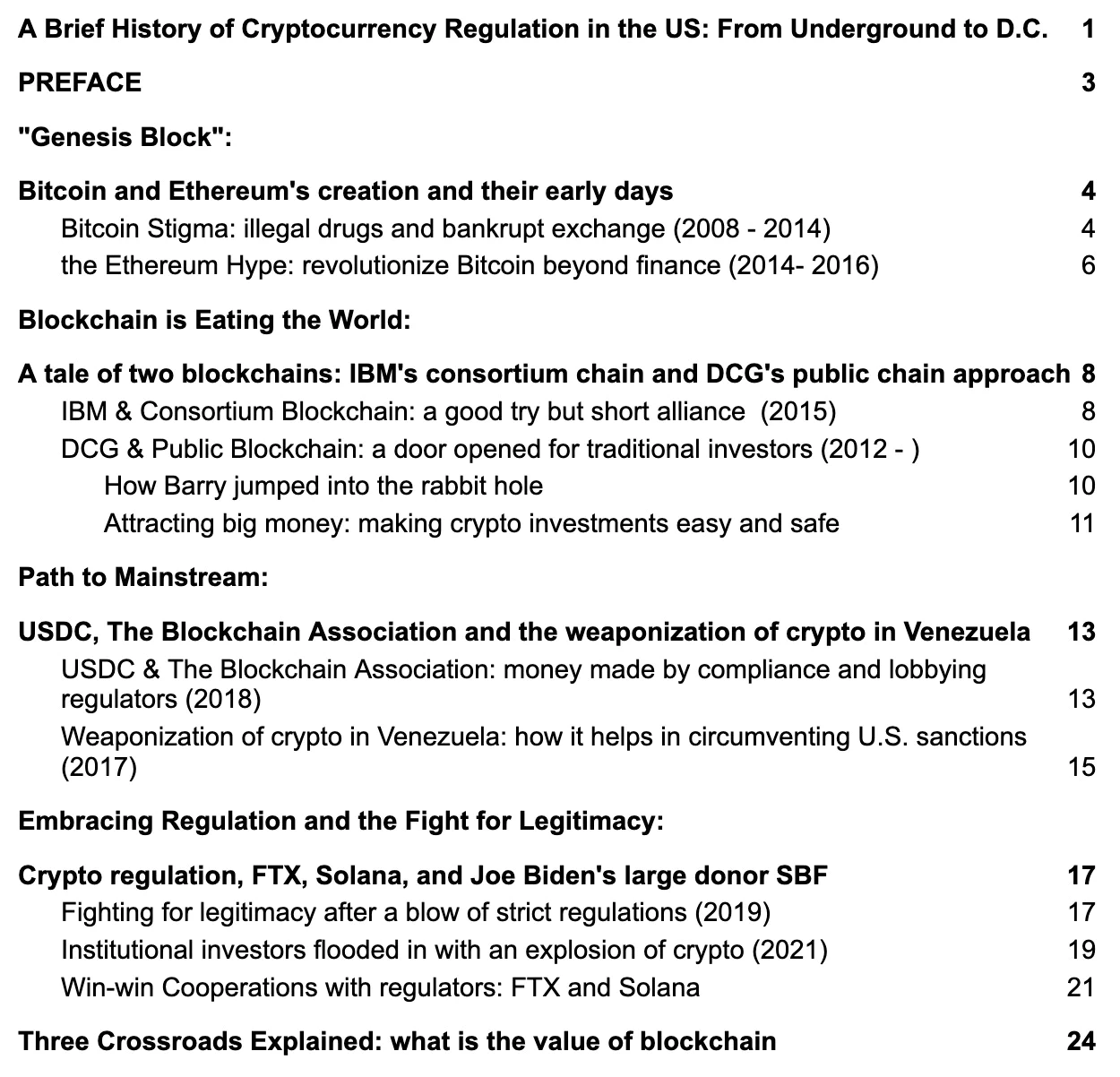
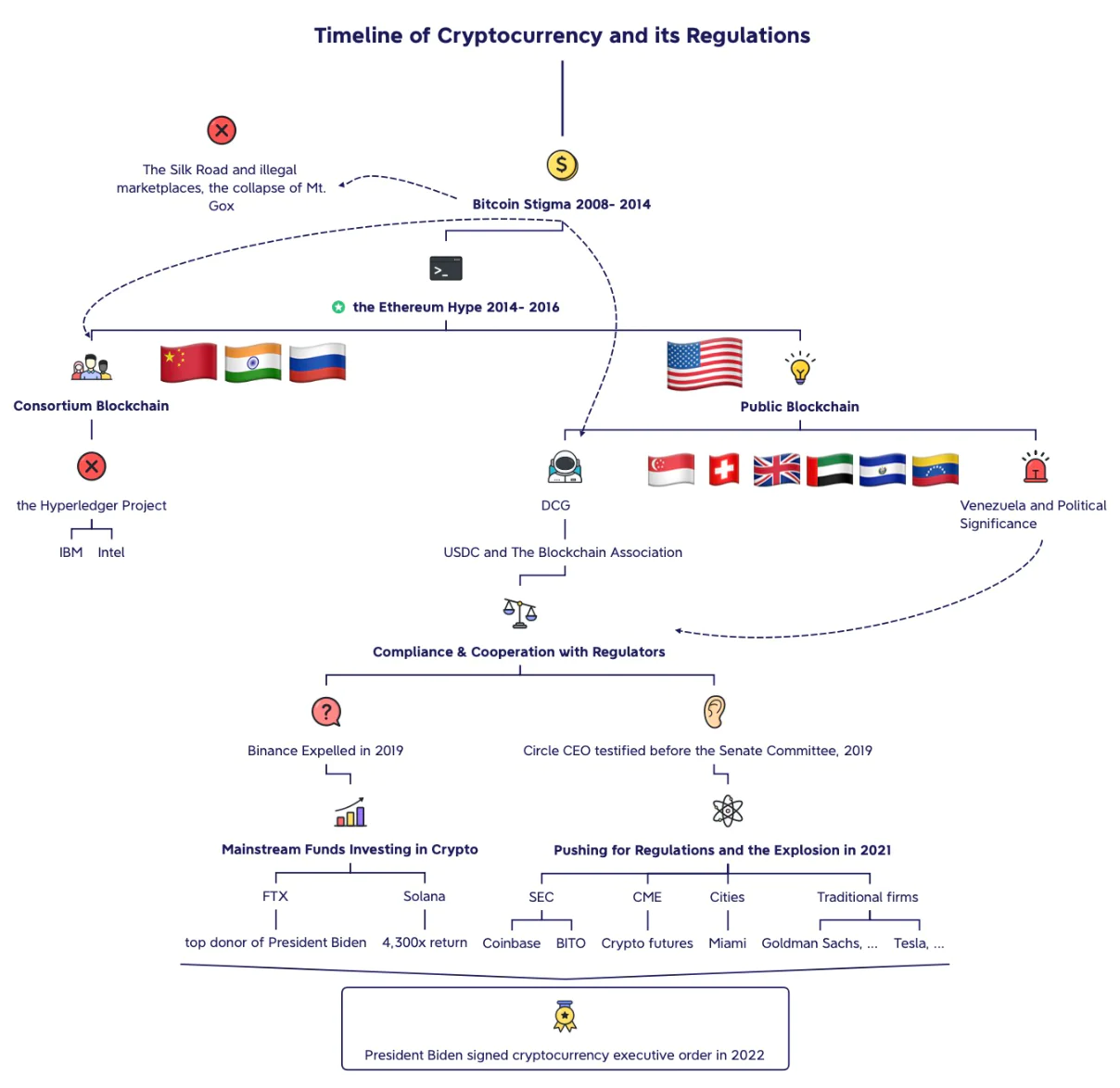
PREFACE
Another round of crypto gold rush cools down while Bitcoin price falls to $30,000, which is half of its highest price in November last year.
As a saying goes: a day in the physical world seems as long as a year in crypto. Looking back, what now has a market cap of more than 1 trillion only has a history of fewer than 15 years. The hype of crypto has been going up and down, each time combining technology advances with new stories to onboard more people into this space.
This round of crypto bull market ends in a narrative of web3, a new generation of the internet that can not only read and write but is also owned by a user. Only weeks before the market crashed, the media were heatedly discussing whether it is worth it for employees to quit web2, while undergraduates were passionately talking about dropping out and going all-in into crypto, all of which sounds like the last hurrah before the party ends.
What newcomers are not familiar with is that it takes a lot for blockchain and cryptocurrency to wash their stigma and become the future of the internet and what we call it today. This process is not only about the technology and its application, but also about the game between regulators and innovators.
Now it’s time to unveil the story.
"Genesis Block": Bitcoin and Ethereum's creation and their early days
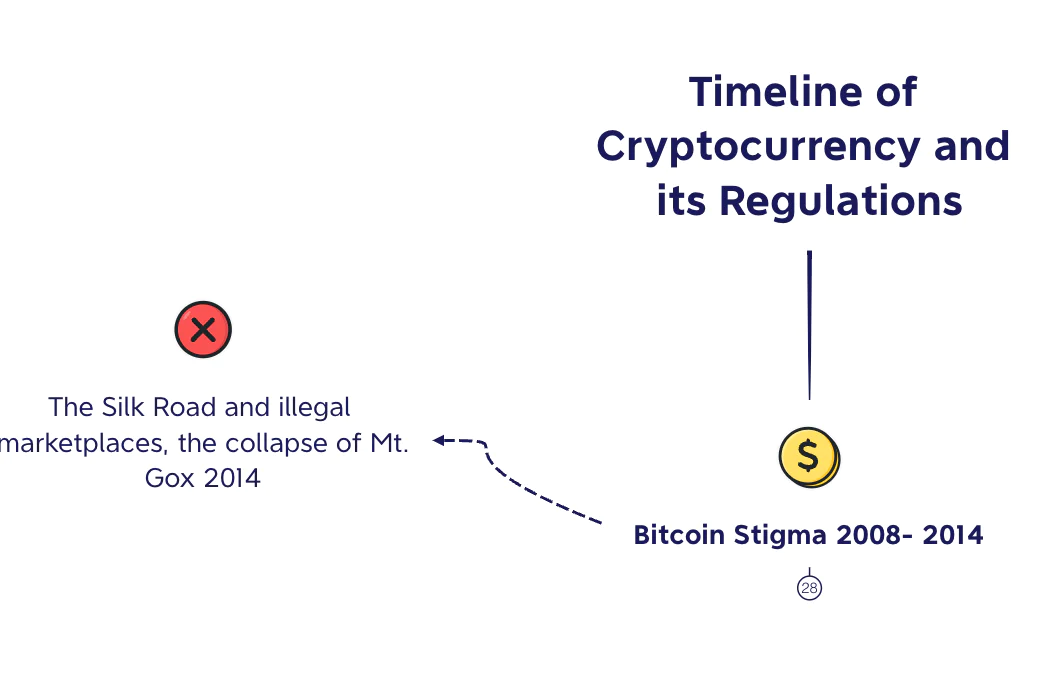
Bitcoin Stigma: illegal drugs and bankrupt exchange (2008 - 2014)
When Bitcoin was invented in 2008 by Satoshi Nakamoto during the financial crisis, it was surrounded by skeptics and none of the decent men would turn an eye to it. In fact, Bitcoin was mostly used for illegal markets and bloody deals.
The underlying technology of Bitcoin is blockchain, which is a peer-to-peer network using cryptography and proof-of-work system to record a public history of transactions. This mechanism allows all its records to be valid without a third party to prevent participants from double-spending, which creates Bitcoin as a digital currency that is not only more economic without any financial institutions but also fully digitalized beyond the boundaries of nations or companies.
At that time, few people bet on bitcoin and believed in such a permissionless future of finance, which sounded too aggressive to be true.
However, the absence of third parties means the absence of regulations as well. Some people started to make use of bitcoin as a digital currency outside the law.
The Silk Road was emblematic of a lot of illegal marketplaces traded via bitcoin. Launched in 2011, it was an anonymous website that transacts illegal drugs and other things. In March 2013, the site had 10,000 products for sale by vendors and created millions of dollars in revenue, which were almost untraceable with bitcoin as its medium of exchange.
These black markets swelled with money launderers and drug dealers raising public concern about the misuse of such cryptocurrencies. Regulators also started to keep up. In 2013 and 2014, the Silk Road was shut down by the FBI twice and its founder was sentenced to life in prison.
This was the beginning of the game between cryptocurrency and regulation, which suggested that a so-called decentralized network would never live in a vacuum and circumvent the traditional legal system.
When concerns about black markets and money laundering were still in the air, another blow for bitcoin came with the collapse of Mt.Gox in 2014, which was the largest bitcoin exchange platform at that time and once represented over 80% of the global Bitcoin trading volume.
On Feb. 7, 2014, this Japan-based company announced to halt all bitcoin withdrawals, for it found out that due to a software bug, a hacker had stolen millions of its assets. When Mt.Gox filed for bankruptcy later in that month, the company said it had lost almost 750,000 of its customers' bitcoins, and around 100,000 of its own bitcoins, totaling around 7% of all bitcoins, and worth around $473 million near the time of the filing.
Bitcoin price plunged as the largest exchange platform halted its activity. This incident raised public attention to bitcoin and also drew harsh criticism on the insecurity and the non-transparency of cryptocurrencies.
More importantly, some critics pointed to the decentralized and trustless promise that was made when bitcoin was created. If bitcoin was bound to be too difficult to transact for non-developers that it had to depend on a centralized exchange platform, what is the meaning of its existence? Not to mention the lack of supervision of such centralized platforms compared with traditional finance, and could cause dramatic loss for users and investors.
This was the first 6 years after bitcoin was born, with dark stories and notorious gossip in the air. It also showed that as Bitcoin grows in prevalence, so does the law’s interest in being able to reach it. Yet, the main goal of regulators is to prevent its damage to society, as if catching a thief.
Blockchain technology seemed to only introduce digital currencies that were circumventing the existing legal system but did not bring anything useful or real-world until Ethereum was born.
the Ethereum Hype: revolutionize Bitcoin beyond finance (2014- 2016)
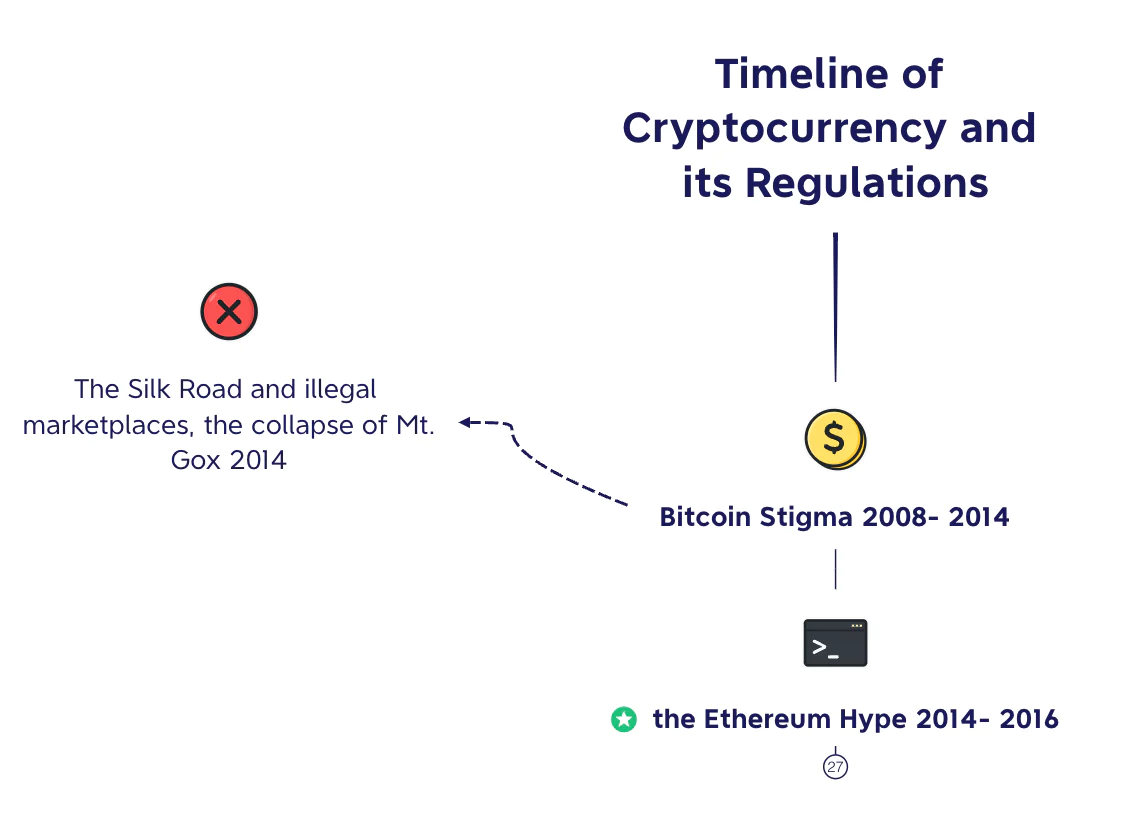
Under the stigma of bitcoin and inspired the blockchain technology, many developers were heatedly discussing how to generalize the idea of distributed ledger and make it usable and valuable for far more than just currency.
These so-called ‘Bitcoin 2.0’ included colored coins, which allowed users to create their currencies on the Bitcoin network. Some protocols like Mastercoin provide specific use cases such as financial derivatives. Meanwhile, the centralized transaction problem raised by Mt.gox also pushed developers to move forward to make peer-to-peer transactions possible through Ricardian contracts (‘smart contracts’).
However, faced with plenty of ideas and problems to be solved, some developers started to realize that the real key to these questions is to innovate the whole infrastructure.
During 2013 and 2014, Vitalik Buterin, a 19-year-old boy born in Russia, introduced his project, Ethereum, to the world, which as he described, was ‘a cryptocurrency network that intends to be as generalized as possible, allowing anyone to create specialized applications on top for almost any purpose imaginable.
Vitalik had great ambition.
Bitcoin was too low-level to create usable applications on top of it and also limited itself to specialized financial applications. The revolution of bitcoin shouldn’t be Bitcoin 2.0 that simulated or was built on the bitcoin protocol, but rather a whole new idea of creating a Turing-complete scripting language that is generalized enough to do anything blockchain-based cryptocurrency potentially can do.
‘Ethereum aims to be a superior foundational protocol, and allow other decentralized applications to build on top of it instead of Bitcoin, giving them more tools to work with and allowing them to gain the full benefits of Ethereum’s scalability and efficiency,’ Vitalik said.
This was how the creation of Ethereum inspired the world. Just as Javascript is a programming language that can build any kind of app of arbitrary complexity, Ethereum is also such a universal scripting language for using blockchain to create anything.
For the first time ever, blockchain enthusiasts saw a brand new future for this technology beyond finance. With Ethereum, it could be anything.
In July 2014, when Ethereum began selling the first batch of its cryptocurrency, investors who had been anticipating it for more than a year bought $2.6 million worth of ‘ether’ tokens overnight.
This marked the launch of ‘the most hyped digital currency since Bitcoin’ according to Business Insider, and Vitalik Buterin was considered as potentially the most important person in cryptocurrency since Satoshi Nakamoto. In 2016, 22-year-old Vitalik was on the list of Fortune magazine's 40 Under 40, which honored the most influential young leaders for the year.
Blockchain is Eating the World: A tale of two blockchains: IBM's consortium chain and DCG's public chain approach
IBM & Consortium Blockchain: a good try but short alliance (2015)
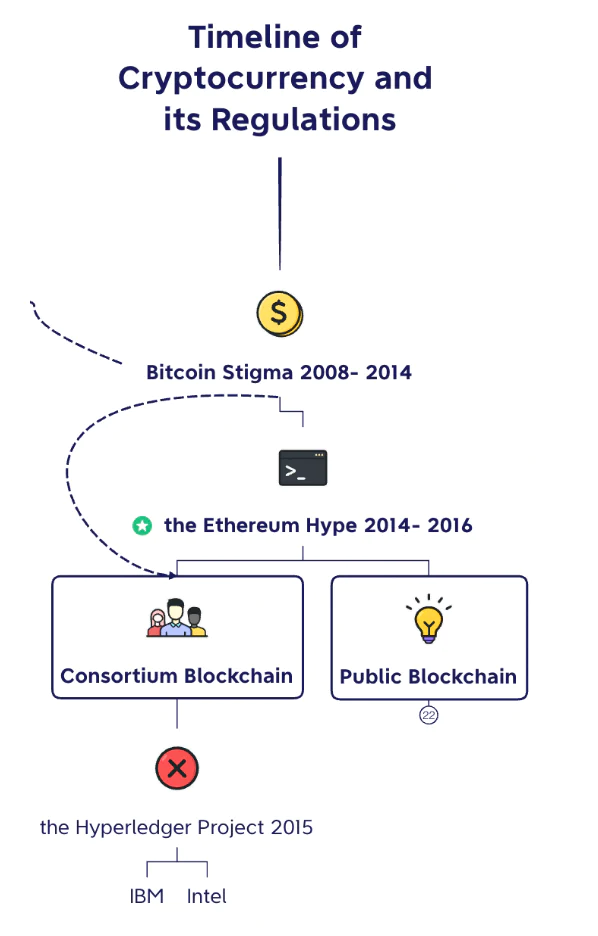
While Bitcoin and Ethereum are using blockchain as a (programmable) financial infrastructure for the future society, big companies and conservatives held their opinions on those tokens outside of laws, yet acknowledging the value of blockchain technology as a public ledger that could bring efficiency.
At the end of 2015, IBM, Intel, J.P. Morgan, and several other big banks announced their joint intent to form the Open Ledger Project together with the Linux Foundation. The goal was to use blockchain to ‘re-imagine supply chains, contracts, and other ways information about ownership and value are exchanged in a digital economy.
Soon in February 2016, the Linux Foundation announced the launch of the Hyperledger Project, an open-source project to advance blockchain digital technology for recording and verifying transactions. 30 founding corporate members included IBM, Intel, J.P. Morgan, Accenture, Blockchain, CME Group, and ConsenSys, etc. Hyperledger Fabric from IBM and Hyperledger Sawtooth from Intel was the first business blockchain framework codebases for the incubation of the Hyperledger Project.
There are two main differences between the Hyperledger (Open Ledger Project) and other blockchains like Bitcoin and Ethereum.
First of all, Hyperledger wasn’t proposing another cryptocurrency but rather wanted to use blockchain technology to create tools to allow businesses to build a distributed ledger for real-world industrial needs. For example, exchanging automotive titles in seconds or paying retail suppliers when a sale is made.
Secondly, the Hyperledger tech was not open to everyone. Only companies elected by the user community could have access to the ledger to generate transactions or even do authenticating works. In Bitcoin, however, every miner could generate transactions and there is no option to close the door.
This kind of blockchain is known as consortium blockchain or federated blockchain. Public blockchains or open blockchains, such as Bitcoin, are accessible to anyone with an internet connection. On the contrary, only pre-selected participants are accepted in consortium blockchain, which is usually used for setting up a system for consensus-building between organizations.
This was how big companies were cautiously embracing blockchain, as opposed to Bitcoin.
“I don’t have a strong opinion on cryptocurrencies, but I have a strong opinion on the blockchain as a solution for contracts and supply chains and the internet of things”, Jerry Cuomo, an IBM Fellow working with the Open Ledger Project said. “I think Bitcoin is an interesting application for blockchain but there are thousands of applications and wider use cases beyond that.”
However, contrary to the rapid growth of public blockchain and its market cap, consortium blockchain was struggling with revenue and was kind of abandoned by the market.
In 2017, more than 15 members of blockchain consortium Hyperledger reduced financial support of the project or left it, including Stock exchange operators of CME Group and Deutsche Boerse.
In December 2017, the Bitcoin price reached a record $18,000, while financing of cryptocurrency and blockchain startups rapidly increased. Despite it, the blockchain technology hadn't been used in one really large project yet, which was probably a reason for the loss of financing and the number of members of Hyperledger.
DCG & Public Blockchain: a door opened for traditional investors (2012 - )
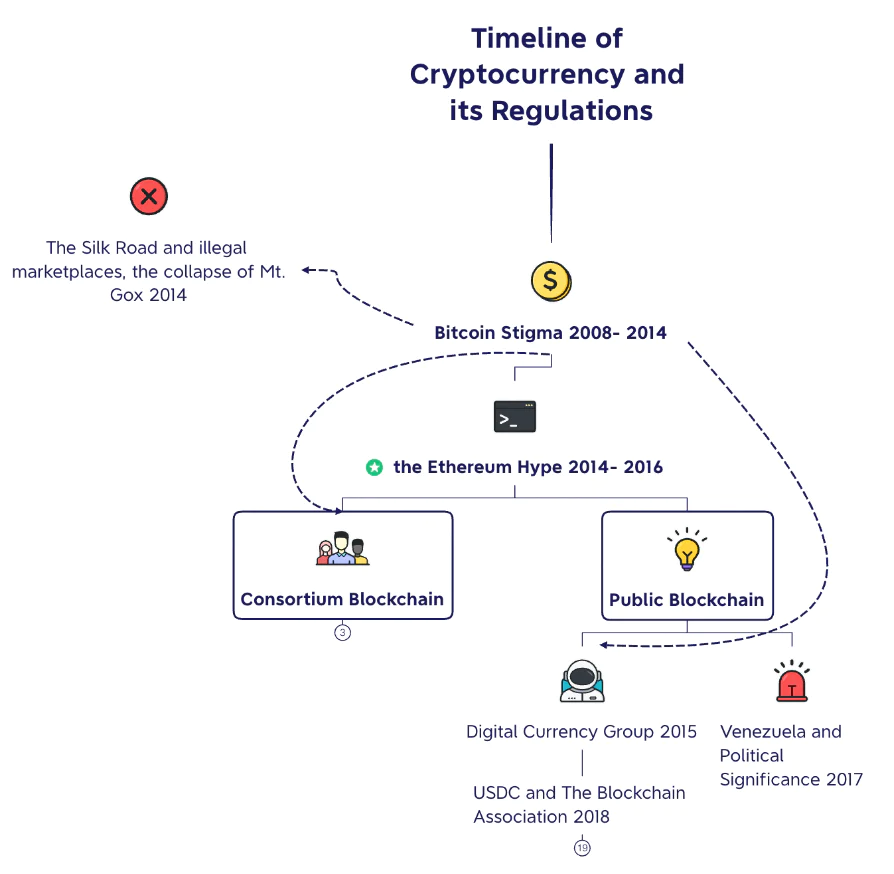
Aside from consortium blockchain, big companies were also finding other ways to get involved in the new trend.
In 2015, Visa, American Express, and Nasdaq all showed interest in blockchain and invested in related companies such as Chain, an enterprise platform for developers to build on top of the blockchain.
MasterCard took a step further. In October 2015, it invested in the Digital Currency Group, which includes a portfolio of Bitcoin and virtual currency companies overseen by Barry Silbert, the founder of SecondMarket. This was MasterCard’s first investment in any kind of digital currency business, which later proved to be a success with huge profits.
The Digital Currency Group (DCG) and its founder Barry Silbert started to stand on the stage of blockchain. Since 2012, they kept building and even leading the industry, relentlessly persuading the regulators and educating the public.
How Barry jumped into the rabbit hole
As a previous banker in traditional finance, Barry Silbert founded Restricted Stock Partners in 2004, which changed its name to SecondMarket in 2008 and operated a secondary market for trading a variety of classes of illiquid assets from bankruptcy claims, and start-up stocks to private company stock and government IOUs.
Not until 2012 did Barry make up his mind to expand his portfolio to Bitcoin.
Barry heard about Bitcoin for the first time in an article about Silk Road in 2011. As a FinTech entrepreneur, he didn’t first get excited about Bitcoin from a technology perspective but rather decided to do research on Bitcoin after reading a book by Charles Hugh Smith entitled An Unconventional Guide to Invest in Troubled Times.
In the shadow of the post-credit-crisis (Lehman Brothers in 2008 and Greek debt crisis in 2010), Barry believed in the idea that there were going to be investments that were non-correlated and would perform well in potentially another round of financial apocalypse.
Even though he thought Bitcoin might be a promising alternative asset, Barry was still skeptical of its regulation side and many other flaws.
It took him 6 months to go through five phases of Bitcoin acceptance. He started off as being dismissive, then skeptical, then curious, and after fully researching and actual investing, finally came to the conclusion in 2012 that Bitcoin really did have the potential to save the world.
The last phase for him was evangelism, in which Barry eagerly started to help accelerate the Bitcoin adoption by using Bitcoin as much as he could, such as using Bitcoin to buy the Amazon gift card.
However, this was clearly not enough. Barry soon realized that in order for Bitcoin to be successful, you had to have the wallets, the exchanges, and many other things in the cryptocurrency ecosystem. So he moved from Bitcoin to investing in related companies, including CoinLab, Bitpay, and so on.
It was the most important and smart decision for Barry to invest in Bitcoin infrastructure with the money made from investing in BTC. The infrastructure was crucial for the success of Bitcoin, but angel investing in those great companies could not only make profits as BTC grows, but also spread the risk of a single investment on BTC at the same time.
Attracting big money: making crypto investments easy and safe
In 2013, Barry started Bitcoin Investment Trust (Symbol: GBTC) with SecondMarket**, together with Chamath Palihapitiya from Social Capital, Lawrence Lenihan from FirstMark, and Scott Murphy, a former Congressman. They bought 3 million dollars of Bitcoin at about $100, which ended up making hundreds of millions of dollars off of that investment.
In 2015, Barry founded Digital Currency Group after quitting his job at SecondMarket as it was sold to Nasdaq. The goal of DCG was to invest in companies in the digital currency and blockchain ecosystem, with a mission to accelerate the development of a better financial system.
It was initially composed of Genesis, the leading bitcoin OTC trading firm, and Grayscale Investments, a digital currency asset management firm that manages GBTC, two former SecondMarket businesses, and other diversified portfolios Barry personally invested in.
The first round of investors of DCG was a group of leading corporate and venture investors, including CME Ventures, FirstMark Capital, who had been familiar with blockchain, and Bain Capital Ventures, CIBC, MasterCard, New York Life, and many other traditional companies, for whom DCG was the first investment in the digital currency and blockchain space.
In 2016, DCG began to show its success. Among all the fundings of 1.3 billion in the blockchain industry, 70% were raised by DCG portfolio companies.
Aside from the venture investments, the most valuable benefit that DCG brought to institutional investors was from the regulation side.
Few people had an idea how hard it was for corporations to buy Bitcoin. Every step, from registering, buying, and transferring to storing cryptocurrencies, required huge amounts of work on compliance. However, DCG provided an easy way for corporations to get involved in this industry with Grayscale Investments.
By investing in Grayscale Bitcoin Trust, Ethereum Trust, or any other Grayscale products, corporations could indirectly, legally, and securely buy digital currencies, and were provided with every filing or service required.
Grayscale opened the door for traditional investors to buy crypto assets. Not only did it simulate huge amounts of investments in crypto as it reduced the friction, but also it provided OTCQX, an active two-sided market, for various kinds of investors to buy or sell.
In 2015, GTBC was listed on OTCQX, the most regulated OTC exchange in the US. Ever since 2017, GBTC continued to be awarded as the top 50 performance in the OTCQX market, with a stunning return of 26293% from 2013 to 2021.
While big companies rushed into this space, Grayscale was growing so fast that its AUM (Asset Under Management) reached 31 billion in 2021, 6 times more than its AUM before 2020.
One of the most important things we could learn from DCG was the importance of regulation and compliance with crypto adoption. We will then see how DCG, along with its partners and portfolios, continued to persuade the regulators and how the lawmakers had gradually changed their minds.
Path to Mainstream: USDC, The Blockchain Association, and the weaponization of crypto in Venezuela
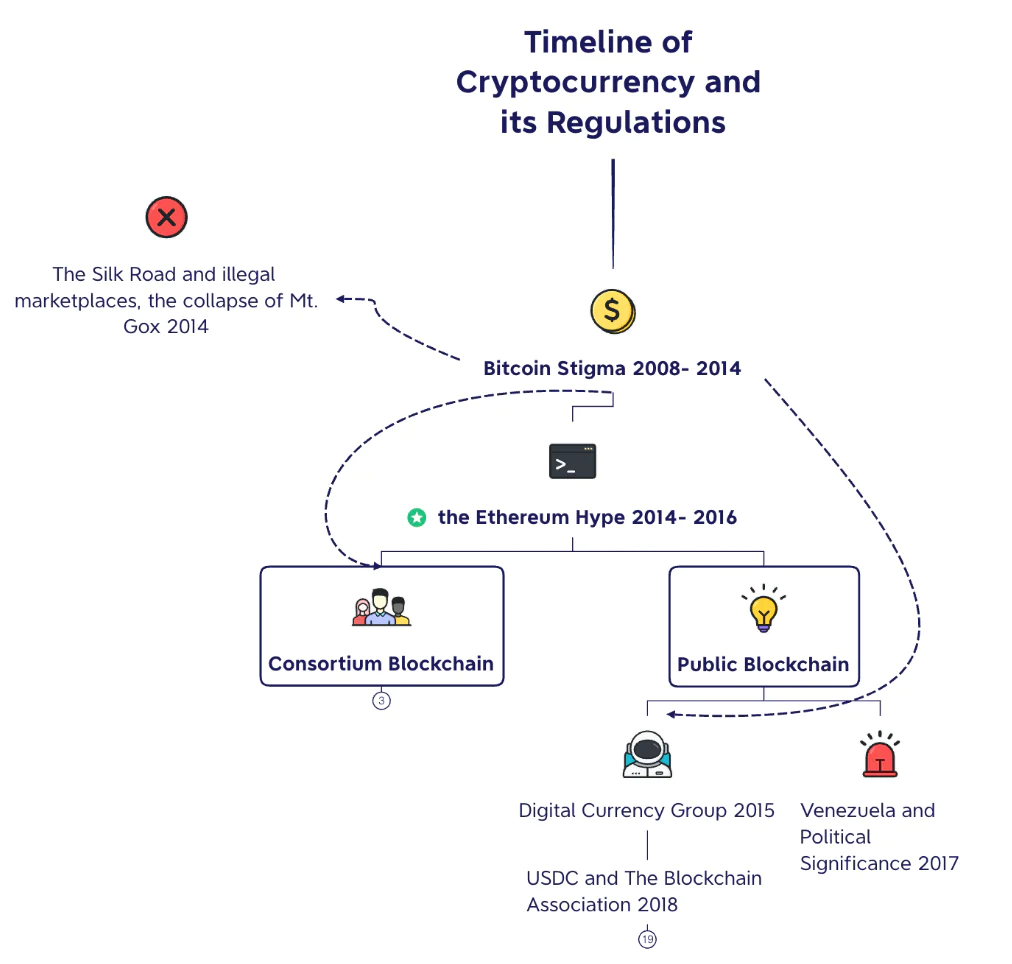
USDC & The Blockchain Association: money made by compliance and lobbying regulators (2018)
In March 2014, DCG invested in Circle, a peer-to-peer payments company that makes it easy to exchange, store, send, and receive bitcoin.
With mobile money transfer apps getting more and more popular, most companies, like PayPal’s Venmo, worked by linking bank account or credit card info to users’ profiles. However, Circle started by transferring money only with Bitcoin, which provided a much easier way for international money transfers.
But paying with Bitcoin was also highly volatile, compared with the stable price of fiat currency. And the other key concern with existing cryptocurrencies was fiat currency-to-cryptocurrency conversion.
These were exactly what Circle aimed to solve. In 2018, Circle launched USD Coin (USDC), a fiat-collateralized stablecoin that could be redeemed for US$1.00 with 1 USDC at any time.
With USDC, everyone had the access to a programmable digital currency that was frictionless to exchange value and safely convert to fiat currency, which could drive global projects and businesses to a great extent. Meanwhile, giving developers a viable way to use real-world currencies in blockchain applications, USDC also offered up new trading, lending, risk-hedging, and other possibilities.
However, all these benefits lay on its reliability in regulation and compliance. Therefore, from the very beginning, Circle realized that robust governance and transparency for compliance was its prior concern.
Unlike its predecessor Tether (USDT) which had been investigated for the adequacy of its reserves, USDC developers were required to maintain full reserves of the corresponding fiat currency and could operate with a variety of financial institutions.
With Coinbase, one of the other leading companies in the industry, Circle created a Consortium called Centre to develop an open standard for stable value currencies to work on blockchains, which required licensing, compliance, technology and operations, accounting, custody of fiat reserves, and so on to become issuers.
During 2020 and 2021, corporations rushed into the crypto market as the Bitcoin price boomed from 7,000 to more than 60,000, and so did the demand for well-regulated stable coins. USDC’s market cap grew from 500 million in 2020 to 53 billion in 2022, keeping up with USDT, the only stable coin ahead of it.
One of the most important keys to USDC’s success was its realization of how crucial compliance was in the so-called decentralized crypto market, for it would spike the expansion of crypto adoption.
Besides its own business, Circle had endeavored to persuade lawmakers and to call on the industry to make explicit standards.
In 2018, The Blockchain Association was launched, whose members included Circle, Coinbase, Protocol Labs, Digital Currency Group, and Polychain Capital. It was a Washington, DC-based non-profit trade association that aimed to have conversations with policymakers that would drive meaningful change for the blockchain ecosystem.
In 2019, Circle CEO Jeremy Allaire as the lone crypto-industry representative testified before the Senate Committee on Banking, Housing, and Urban Affairs about the industry’s need for regulatory clarity.
Some of his statements included that it was just impossible for governments to ban crypto for they existed everywhere the internet existed. Secondly, explicit regulations were so important for the mainstream adoption of crypto that policies should keep up with the pace of innovation, or America would fall behind and not reap the economic benefits of blockchain technologies.
With the joint efforts of these crypto pioneers and their conversations with policymakers, we could see that the regulators, from the congress to SEC, had been changing their minds on crypto from criminal transactions to something innovative and worthed attention, which could probably benefit the country and even the world.
Weaponization of crypto in Venezuela: how it helps in circumventing U.S. sanctions (2017)
International conflicts brought cryptocurrency out of the niche space of the tech industry, which had shown its political significance and urged regulators to take action.
To the south of the US, Venezuela is a land blessed with immeasurable resources. Sitting on the world’s largest known oil reserves, petroleum fueled Venezuela’s rise and dominated its exports and government revenues.
However, due to poor policies and political instability, the country struggles with hyperinflation, shortages of basic goods, severe crime and corruption, and other crises in people’s livelihood. In 2016, its economy regressed by 8% and it suffered from inflation of 481.5% according to the IMF.
Sanctions from the US made it even worse. Since 2017, the US has sanctioned people, businesses, and oil entities associated with the Maduro regime, who later became the president of Venezuela in 2018, both inside and outside of Venezuela.
The U.S. further imposed broader economic sanctions and financial embargo on Venezuela in 2018, including a ban on the export of crude oil from Venezuela and the exclusion of the country’s financial system from SWIFT.
As hyperinflation and U.S. sanctions disrupt Venezuela's economy, cryptocurrency emerged as a tool to send remittances, protect wages from inflation and help businesses manage cash flow in a quickly depreciating currency.
In 2017, Venezuelan President Nicolas Maduro announced the creation of the state-backed petro cryptocurrency, which was then used to make small payments to retirees, and advertised by the government as a currency for exchanging oil and gold.
Aside from petro, other mainstream cryptocurrencies were also used as a palliative for the economic situation. Even restaurants and supermarkets accepted bitcoin as payment.
"Nobody is going to tell you 'every night when we do the books, we convert bolivars (the basic unit of money in Venezuela) into bitcoin,' but yes, this is happening," said Aaron Olmos, an economist and finance expert interviewed by Reuters.
For the U.S. government, this was the first time when its economic sanction on a country was violated, which was a circumvention made by cryptocurrencies.
In 2020, the U.S. amended its executive order to add cryptocurrencies to the list, which further prohibited U.S. persons from transacting in any digital currency issued by the former Maduro regime. Meanwhile, businesses paid with bitcoin, Ethereum, or any other cryptocurrency also might be sanctioned by the U.S. government.
However, could it work successfully?
On the contrary to big banks, cryptocurrency was borderless, decentralized, and a virtual space out of the control of a single government. In June 2021, Bolivar operations rose by 75% on Binance, the biggest cryptocurrency exchange in the world whose employees were distributed in 40 countries without having a headquarter.
Venezuela rang the bell for the U.S. government that cryptocurrency was not only a business or technology but also a weapon that could potentially undermine its political strength on the global stage.
Embracing Regulation and the Fight for Legitimacy: Crypto regulation, FTX, Solana, and Joe Biden's large donor SBF
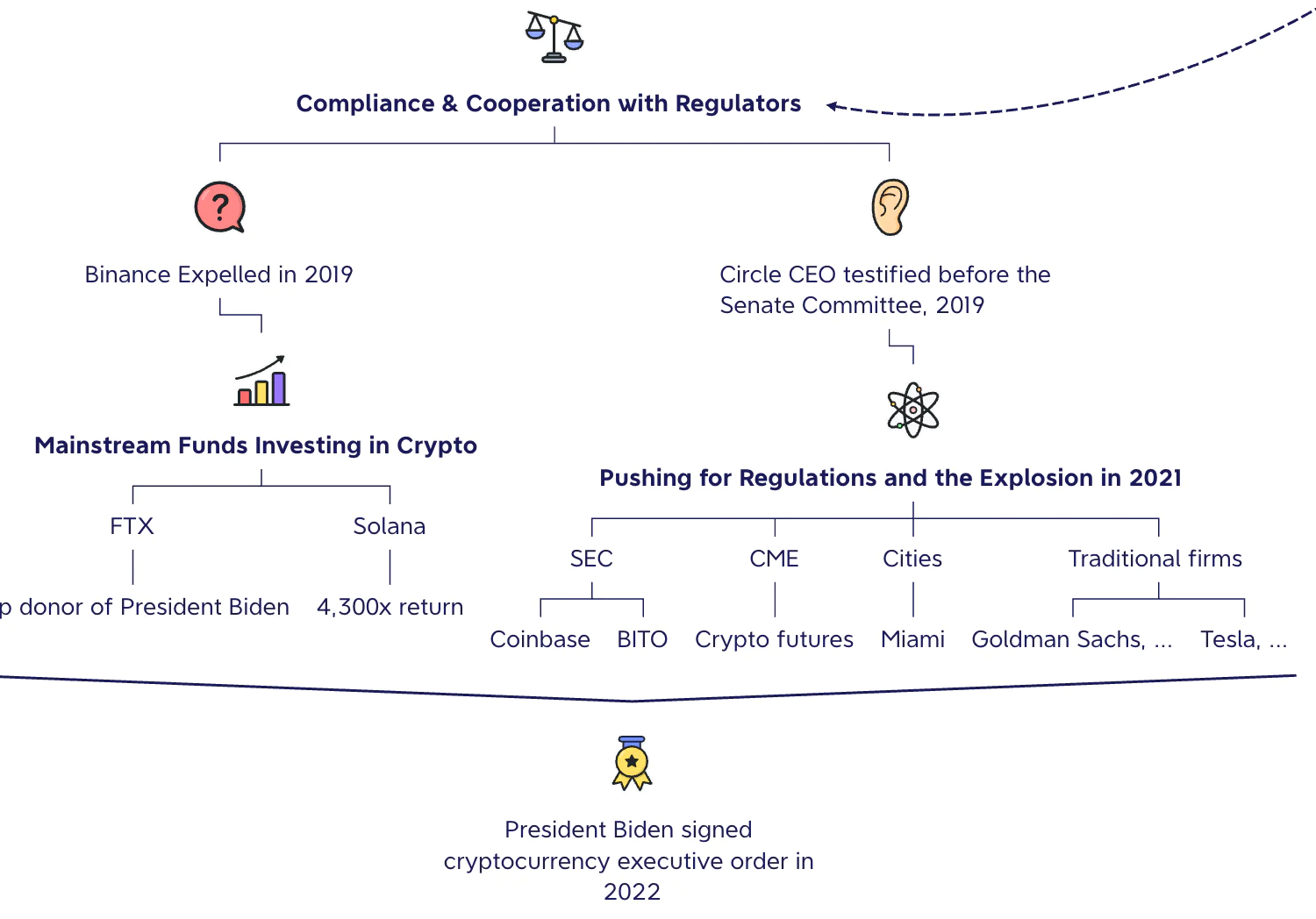
Fighting for legitimacy after a blow of strict regulations (2019)
After the Mt. gox exchange was hacked in 2014 and the filthy ICO (initial coin offering) scams in 2017, more and more in the crypto world have been figuring out how to ensure the basic ethical rules in a space without the government.
Cryptocurrency exchanges seized this opportunity and earned millions.
In January 2019, Binance reopened its IEO (initial exchange offering) launchpad along with other exchanges like OKEx and KuCoin, offering an extra layer of security and reliability for tokens on their platforms for transactions and trading.
IEOs were the hottest token fundraising trend of early 2019. Through commissions and transaction fees, exchanges made a huge profit as an intermediary between a buyer and a seller and played the role of the judge when it comes to listing a new startup token.
It was a trade-off to the benefit of exchanges whether to list more tokens for hefty fees or to list fewer tokens with higher reliability. Though Changpeng Zhao, the CEO of Binance, said that they were always trying to be the most ethical exchange in crypto, it was still suspicious for regulators to believe that a private company driven by profit could shoulder the public responsibility.
Unsurprisingly, regulators soon kept up, trying to funnel U.S. investors into regulated channels.
In July 2019, Binance was banned from operating in the U.S. and opened Binance.US to comply with local laws. After announcing that it was reviewing user accounts to ensure they follow Binance's terms of use and know-your-customer (KYC) procedures, it then stated that "Binance is unable to provide services to any U.S. person."
Meanwhile, crypto exchange Bitfinex and Tether, the largest stablecoin that said it held a dollar in cash for every tether token in issuance, were accused by New York’s top lawyer. The New York attorney general alleged that Bitfinex used at least $700 million from Tether’s cash reserves to cover up an $850 million loss.
Cryptocurrency issuers were also increasingly concerned about whether American regulators would consider their token a security – and thus subject to much-maligned securities legislation that dates back to the early 1930s.
On April 3, 2019, the SEC released a Framework that identified tokens as securities when they meet the criteria set by the Howey Test, which limited the possible uses of utility tokens. According to the Howey Test, tokens are viewed as securities by regulators when there was an investment of money, a common enterprise, and a reasonable expectation of profit through effort. To be considered a utility token and not a security, a token must be for consumption only.
After the blow of strict regulations, crypto entrepreneurs in the US realized even more deeply how much compliance was worth. They kept lobbying the regulators, stating the benefits of crypto and its irreversible trend. When they urged for regulation certainty to ensure US’s leadership in finance and technology, they were fighting for their own legitimacy at the same time.
At the end of July 2019, representatives of the crypto-industry, finance, and law testified before the Senate Committee about the types of digital currencies, their infrastructure, application, and the potential benefits and detriments of each.
While the CEO of Circle argued for its innovation in the payment system and called on the industry’s need for regulatory clarity, the senator mostly worried about handing those kinds of public resources to Wall Street or some tech company might give them a chance to squeeze more profits out of ordinary Americans and would break that critical public infrastructure.
However, it was not to say that the regulations should be black and white, or that we just needed more regulations for a new industry. Rather, the clarification of regulations and its adaptation to a new kind of asset was the priority, which could give regulatory certainty to consumers and businesses in the cryptocurrency market.
Especially considering the international competition, some countries like Singapore had already used regulation as a way to attract cryptocurrencies to their borders.
For these tokenized digital assets that just couldn’t be banned or disappear on the earth, U.S. regulators came to realize that it was something they had to address because if they, as a country, did not lead in this technology, China or some other country was going to do so.
Explosion in crypto made the last push (2021) | Institutional investors flooded in with an explosion of crypto (2021)
After years of evangelizing, crypto enthusiasts had made their voices heard by the regulators.
More importantly, a large number of institutional investors jumped into the space and thus joined in pursuing positive regulations for their own interests.
The second quarter of 2019 marked the first time Coinbase reported institutional trading volume exceeding retail volume since early 2018. Every quarter since, the exchange has seen institutional trading exceed retail volumes.
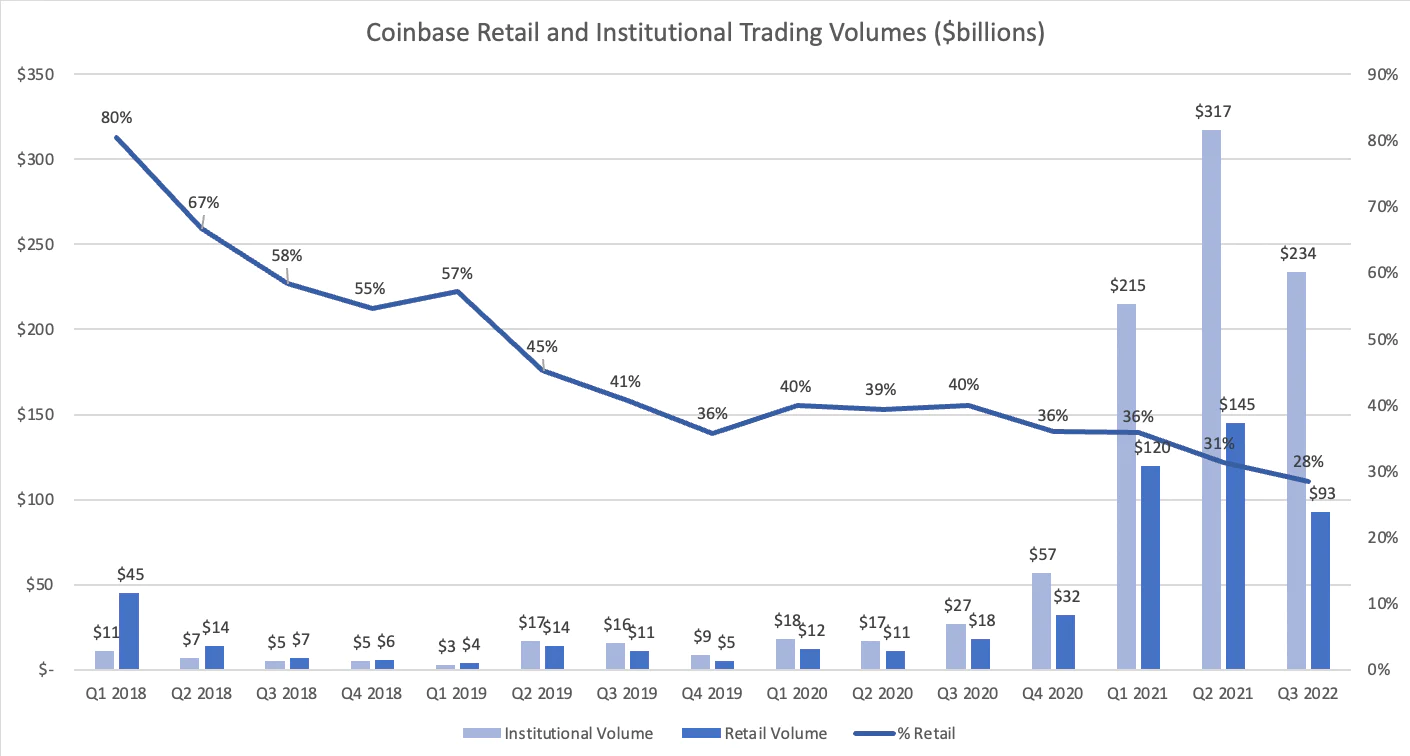
In 2021, with another round of bull market, a positive turning point showed up in the US crypto policies.
In February, President Joseph R. Biden nominated Gary Gensler as the chair of the U.S. Securities and Exchange Commission (SEC). Before working at SEC, Gensler was a professor at MIT and taught a course entitled "Blockchain and Money". He was considered crypto-friendly and a specialist in policies on digital currencies.
Soon after, several milestones for the crypto industry were made, which proliferated institutional market access beyond Grayscale products and the CME futures market.
In April, Coinbase, the biggest crypto exchange in the US at that time, was listed on the Nasdaq stock exchange, marking the first major cryptocurrency company to list its shares on a U.S. stock exchange. Coinbase’s listing opened the door for traditional investors to invest in digital currencies in an indirect way, which was a landmark moment for the crypto space.
In October 2021, the first official Bitcoin-linked ETF (Exchange Traded Fund), the Proshares Bitcoin Strategy ETF (BITO), was approved by the SEC and listed on the New York Stock Exchange. As a Bitcoin ETF, BITO purchased and held bitcoin to correspond to the performance of bitcoin, which not only provided a familiar way to gain exposure to bitcoin returns, but also the liquidity and transparency of an ETF.
Besides the SEC, many other politicians and regulators also focused on strengthening market integrity and fostering innovation. CME added to their stable of Crypto futures with the launch of ETH futures and micro BTC futures geared towards smaller investors.
With a major implication for the cryptocurrency industry, The New York Attorney General’s office settled with Bitfinex and Tether, ending a two-year closely watched inquiry into reserves at the stablecoin issuer. Under the terms of the settlement, Bitfinex and Tether would admit no wrongdoing but will pay $18.5 million and provide quarterly reports on its reserves for the next two years, which was considered a relief for Tether.
Miami Mayor Francis Suarez was even selling his city as a hub for Crypto innovation, offering to pay public employees and accept taxes in Crypto. In another surprise, Crypto exchange FTX won naming rights for the home arena of the Miami Heat.
While regulations provided more access and certainty for the market, the year 2021 was the time of the Cambrian Explosion in Crypto.
Many traditional financial services firms revived their Crypto trading efforts which had been shelved since the 2017 ICO bubble popped, including Goldman Sachs, Morgan Stanley, and BNY Mellon. Meanwhile, Tesla, Microstrategy, Meitu, Paypal, Visa, and more corporate and merchants adopted crypto as their treasury reserves.
Regulators actively put efforts to research this new market and put forward regulations to both regulate and foster a promising industry.
Just like every progress that society has made, this will not be settled once and for all. Rather, the regulators will always keep up with the technology as it develops and creates new problems.
In 2022, as the stablecoin UST crashed with LUNA and USDT fluctuated, the SEC revealed its plan to double the size of its Crypto Assets and Cyber Unit and showed determination to push for more crypto regulation, especially on the stablecoins.
Win-win Cooperations with regulators: FTX and Solana
Aside from pushing for regulations, governments could do more: investing is another way.
In this whole process of the rise of Crypto, the U.S. was deeply involved, fostered, and then benefited from the industry. FTX was an example of how the U.S. was seeking to expand its power in new technology by investing in it.
While Binance was expelled by the U.S. government in 2019, another Crypto exchange FTX was founded, which then surpassed Coinbase and became the second-largest crypto exchange in volume in only two years.
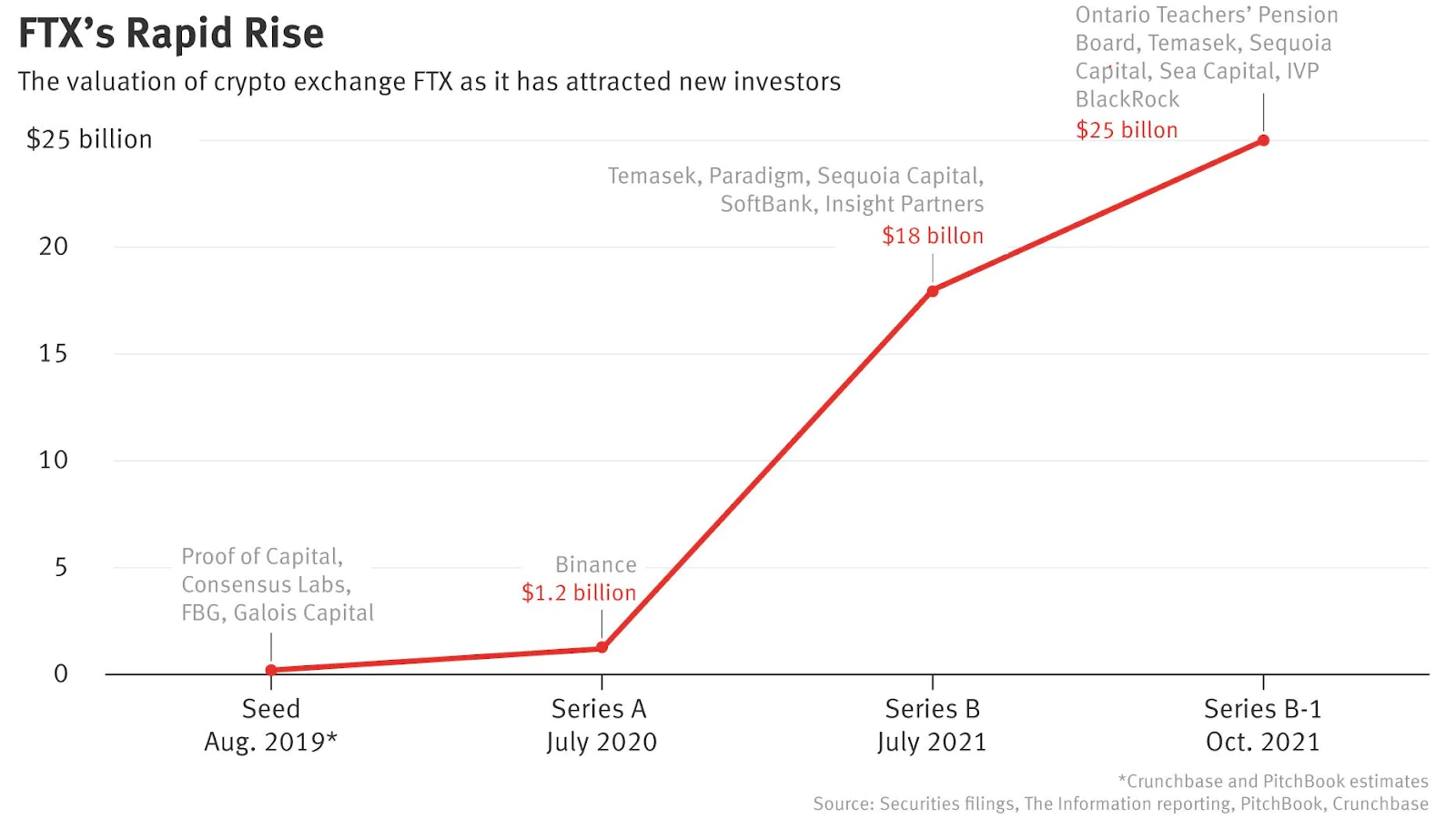
Founded by Samuel Bankman-Fried (SBF), who was a former trader at the quantitative trading firm Jane Street, the Bahamas-based FTX has grown so quickly that its valuation soared from 1.2 billion in 2020 to 25 billion in October 2021, rising nearly 40% from its last funding round in July.
At the same time when FTX was celebrated with its financing, Binance was having troubles with regulators, which caused multiple payment processors to cease doing business with the big crypto exchange in Europe. Their reluctance to work with the Binance profoundly affected its key functions to perform.
Compared to Binance’s hardship with regulators throughout its history, FTX and its CEO SBF, whose parents were law professors at Stanford, seemed shrewder in forging relationships with regulators.
When asked about the strategy of government relations in an interview in July 2021, SBF expressed that he thought the goal of a lot of the regulators wasn't to screw over businesses but to find some way that they could help industries thrive while also making sure that they have the controls in place that they find important.
It was exactly what the U.S. government was seeking: to have control in and to foster its own great corporations in this industry of strategic importance.
As Binance was expelled and ran to Singapore and the United Arab Emirates, FTX had been making huge progress in cooperating with the US regulators.
In 2020, SBF was one of the top donors that contributed $5,220,000 to Biden's presidential election campaign against President Donald Trump.
FTX had also been attracting larger, mainstream investors. According to the Information, its latest funding round includes Ontario Teachers’ Pension Plan Board, Tiger Global Management, and BlackRock, whose returns were impressive as FTX’s valuation spiked 25x in less than three years.
Some of the larger funds also doubled down. Temasek Holdings, owned by the Singapore government, and Sequoia Capital invested both in July’s Series B and the round in October 2021.
The success of FTX in the US shows that the relationship between crypto and regulators is not a zero-sum game, but potential win-win cooperation with mutual efforts.
Mainstream investors in the U.S. also benefited a lot from investing in some of the successful crypto ventures and start-ups.
Union Square Ventures (USV) was one of the best American venture firms founded in 2003 whose LPs (Limited Partners) were some of the largest mainstream investors in the country, such as Massachusetts Pension Reserves, the University of Texas/Texas A&M, and Washington State Investment Board.
USV waded into crypto ahead of most firms. It invested in Coinbase in 2013 and owned 8.2% of its Class B shares at the time of its direct offering in 2021. Other bets in crypto included Polygon, Algorand, Dapper Labs, Protocol Labs, and Multicoin Capital, which was a crypto ventures fund that was the early investor of Solana.
Multicoin Capital, along with Race Capital founder, 500 Startups, and other early backers, had reaped huge gains from the investment of Solana Labs, which were worth about 4,300 times their initial sales price and in some cases generated $1 billion in returns, according to the Information.
The incredible spike in the price of the blockchain’s tokens explains why more VC funds want to hold these assets, and traditional venture capital firms such as Andreessen Horowitz and Sequoia Capital are even shaking up their legal structures to hold more digital assets.
Advances in blockchain technology for financial services have led to dramatic growth in markets for digital assets.
As the domestic crypto market thrives, It becomes clearer for the U.S. regulators that they should make further moves, regulating or investing, to reinforce the United States' leadership in the global financial system and technological and economic competitiveness.
In March 2022, President Biden signed a cryptocurrency executive order on “Ensuring Responsible Development of Digital Assets”. He stressed the strategic importance of developing the cryptocurrency, so that ‘‘continued United States leadership in the global financial system will sustain United States financial power and promote United States economic interests.’’
Three Crossroads Explained: what is the value of blockchain
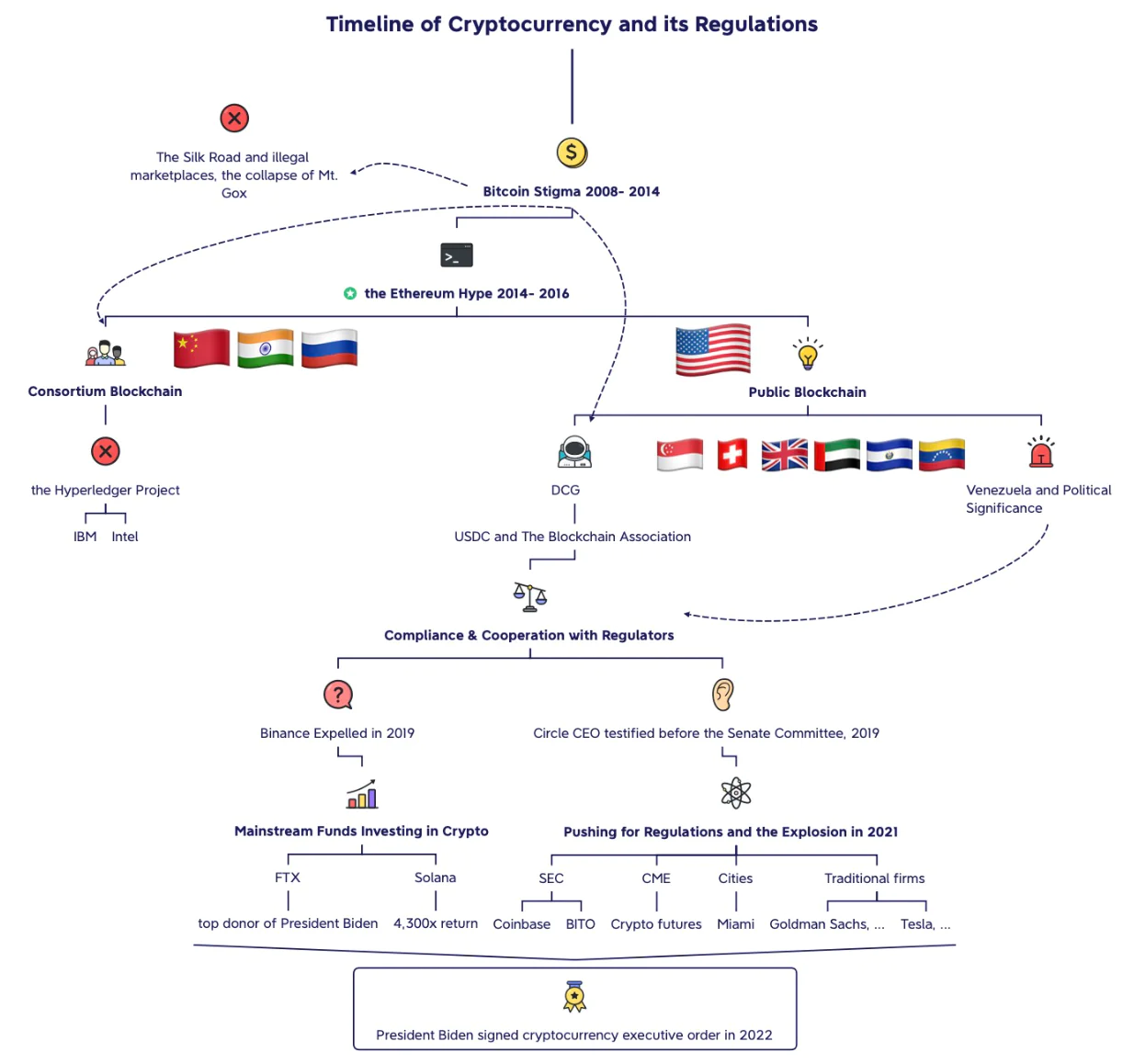
Looking back, three crossroads in the history of blockchain come into view.
The first one is between Bitcoin and Ethereum.
Although Ethereum was created in the light of Bitcoin, people were holding different opinions on which one would thrive in the future. It gradually turned out that the vitality of programmable assets that Ethereum introduced was endless compared to Bitcoin, which provided a digital currency of a single use.
In other words, Ethereum opened up the door of possibility for blockchain to be usable and valuable for far more than just currency. As we could see, all the innovations and digital assets later on, such as Defi and NFT, were all realized by the permissionless digital infrastructure invented by Ethereum.
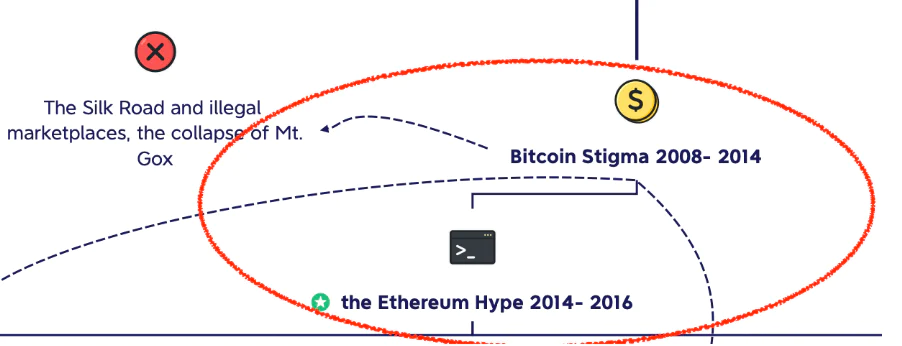
Secondly, there comes the crossroad between consortium blockchain and public blockchain.
At first, countries like the US and China all made efforts to encourage and explore the use cases of consortium blockchain, which were considered to be a way to improve efficiency in traditional industries. However, while China still insisted on consortium blockchain, the Hyperledger Project had been collapsing and the US had changed its way to the promising public blockchain.
Why does the consortium blockchain fail?
Some might think that it is because blockchain technology hasn't found its real application in traditional industries like supply chains. But these are only the results and not the cause.
To figure out the underlying reason, we come up with the question of what exactly is the value of blockchain?
Crypto = a digital & permissionless infrastructure for a digital world
The most valuable thing that blockchain brings is an infrastructure for digital assets in a digital era. By creating a new kind of asset, cryptocurrencies and tokenized economy revolutionize the relations of production and thus liberate productivity (platform vs user in Web2), thus liberating productivity and capital mobility.
Everyone can create or own digital assets in a permissionless way, whose transfer is frictionless and financing is borderless in a virtual community. All of these opportunities for fortune and innovation result in a huge stimulation of creativity, while the traditional financial system is being restructured.
In other words, blockchain is born to create new assets, not just a ledger for improving information communication.
Therefore, the history of blockchain shows that only when blockchain is used for creating assets or improving its financial system that set the trend, such as the boom of cryptocurrencies and NFTs.
As far as the downsides are concerned, KYC or other regulatory procedures on its upper layer can still prevent disruptions or scams due to its permissionless basis. Meanwhile, the new hype of x-to-earn shows that digital currencies are also permeating the real world.
On the contrary, however, when consortium blockchain aims to be permission-needed in the first place, people just won’t use those products that don't bring out new things, which end up being a struggling financial-data-service business for corporations and governments.
For example, while companies tried hard to combine blockchain with real-world supply-chain or real estate, what really made a hit was Bored Ape and its native digital land in the metaverse.
Crypto only makes sense when it is the underlying layer. Adding crypto to traditional assets might even lower its efficiency.

Finally, there was the crossroad for regulators of different countries, whether to ban crypto or to support it and view it as a potential source of growth.
Some countries, such as Malta, Singapore, and Switzerland, were among the pioneers striving to become cryptocurrency hubs. Others stood in the middle of the crossroad, allowing the development of cryptocurrencies while developing regulations to minimize risk.
With hefty investments and dramatic growth of Crypto, more and more countries embraced the trend and made their decision. The US regulators exemplified those who began to change their attitude from being suspicious to helping and having control in this industry. For example, in the case of Tether and USDT, US regulators finally settled with Tether by fining instead of blocking it for good.
On the contrary, China still stuck to its strict ban on Crypto and only supported consortium blockchain due to its concerns about government control of the financial sector, financial stability, and consumer protection. Without certainty in regulations, Chinese crypto investors and entrepreneurs are crowding abroad into Singapore and other countries that actively attract cryptocurrencies with favorable regulation and tax regimes.
As innovators march forward, those who choose to catch up with the trend are those to be chosen by it.
In memorial of tt, a diligent evangelist, a thoughtful teacher, and a brave sailor chasing the light.
A month ago, I started writing this article under the instruction of @taorongqi_1 & @looksrare_eth, without realizing that this would be the last time.
We were still discussing this article before all of a sudden he passed away.
He patiently explained to me the crossroads along the way crypto had developed, and what he thought was the true value blockchain had brought to the world.
As a boss, he was sincere and passionate, wearing a big smile all the time. He brought me on the journey of blockchain and guided me till his last breath.
R.I.P.
Disclaimer: As a blockchain information platform, the articles published on this site represent the personal views of the authors and guests, and have nothing to do with Web3Caff's position. The content of this article is for information sharing only, and does not constitute any investment advice or offer, and please comply with the relevant laws and regulations of your country or region.



















